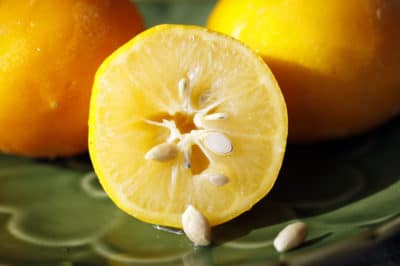Meyer Lemon History
In 1908, agricultural explorer Frank Meyer imported the first hybrid lemon trees bearing his name to U.S. backyards. Native to China, the trees quickly caught on thanks to their sweet — and remarkably juicy — year-round fruit. But by the 1940s, nearly all of them were identified as symptomless carriers of the deadly tristeza virus and destroyed.
The Survivor
Only one virus-free strain of trees escaped to become the Meyer lemon of today. Discovered in 1950 and released to commercial growers in 1975, it’s officially known as ‘Improved’ Meyer (Citrus x meyeri ‘Improved’). Since then, the traits separating it from other lemon trees (Citrus limon) has made the ’Improved’ Meyer lemon tree a gourmet and gardener favorite.
How Are Meyer Lemon Trees Different?
Despite what we call them, lemons and Meyer lemons have some significant differences:
- The most popular commercial lemon trees — ‘Eureka’ and ‘Lisbon’ — are true lemon (Citrus limon) cultivars. Meyer lemon trees are thought to be hybrids of pomelos (Citrus maxima), mandarins (Citrus reticulata) and sweet oranges (Citrus sinensis).
- If given frost protection below 29° F (-1.7°C), true lemon trees grow in USDA plant hardiness zones 9 through 11. Meyer lemon trees growing in USDA zones 8 through 11 tolerate cold down to 23°F (-5°C) before suffering injury.
- Unless grafted to dwarfing rootstock, true lemons can grow 15 to 20 feet tall. When planted, Meyer lemons reach 8 to 10 feet but as potted plants, they seldom grow more than 4 feet high and wide.
- Both true and Meyer lemon trees flower and fruit throughout the year, but each has its own peak fruiting seasons. For Meyer lemons, it’s in fall and winter. For ‘Eureka,’ it’s from late winter into early summer. ‘Lisbon’ peaks from winter into early spring.
Differences in Fruit
Much rounder than true lemon fruit, Meyer lemons have very thin, orange-tinged yellow peels and deep-yellow pulp. The smooth peels contain so little bitter white pith that they’re actually considered edible. They’re also very fragrant. The exceptionally soft and juicy pulp is much less acidic than that of true lemons.
Larger, more oblong true lemons have pebbly, thick sunny-yellow skin and medium-yellow pulp. Bitter white pith covers their tangy, mouth-puckering fruit.
